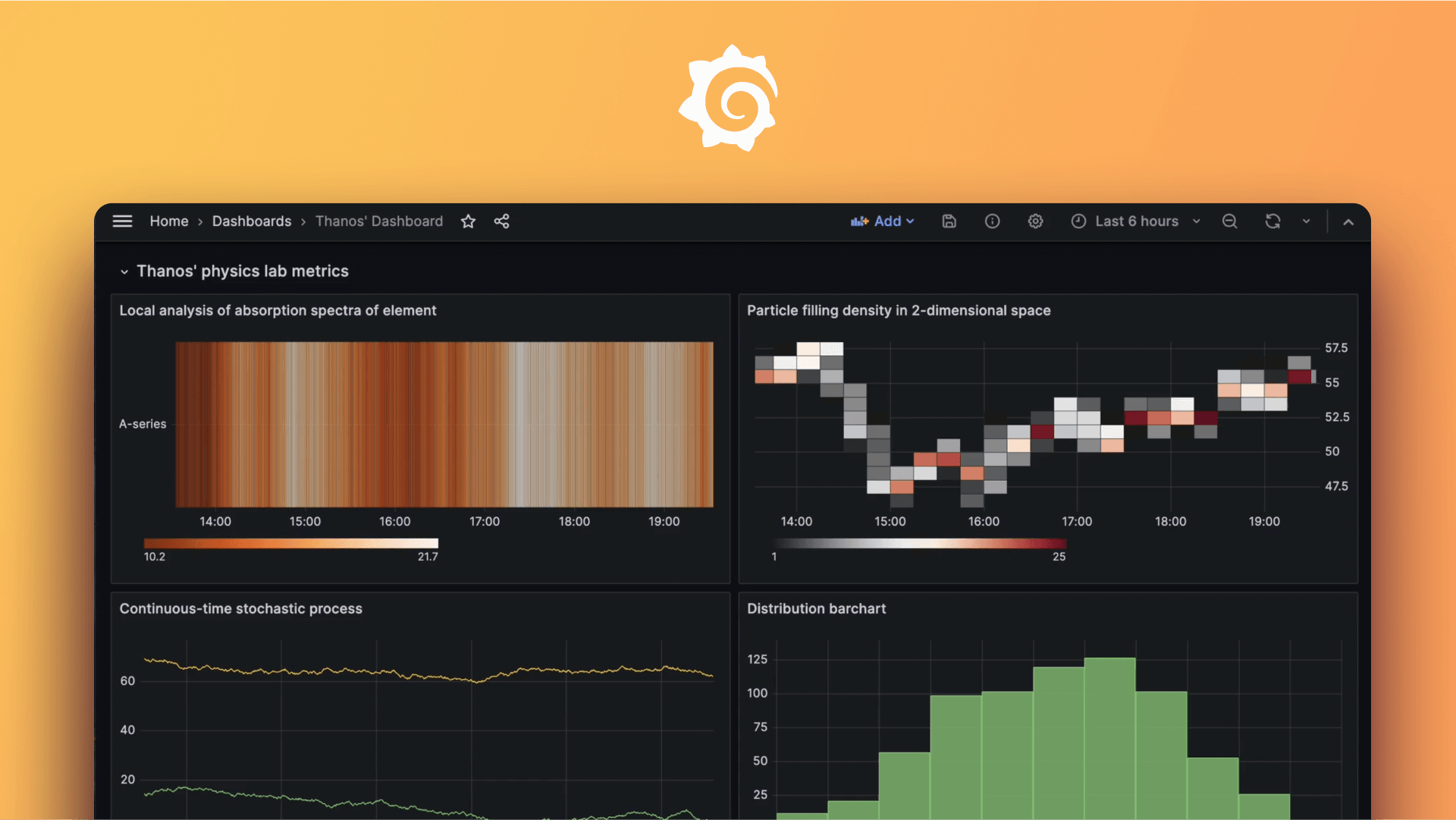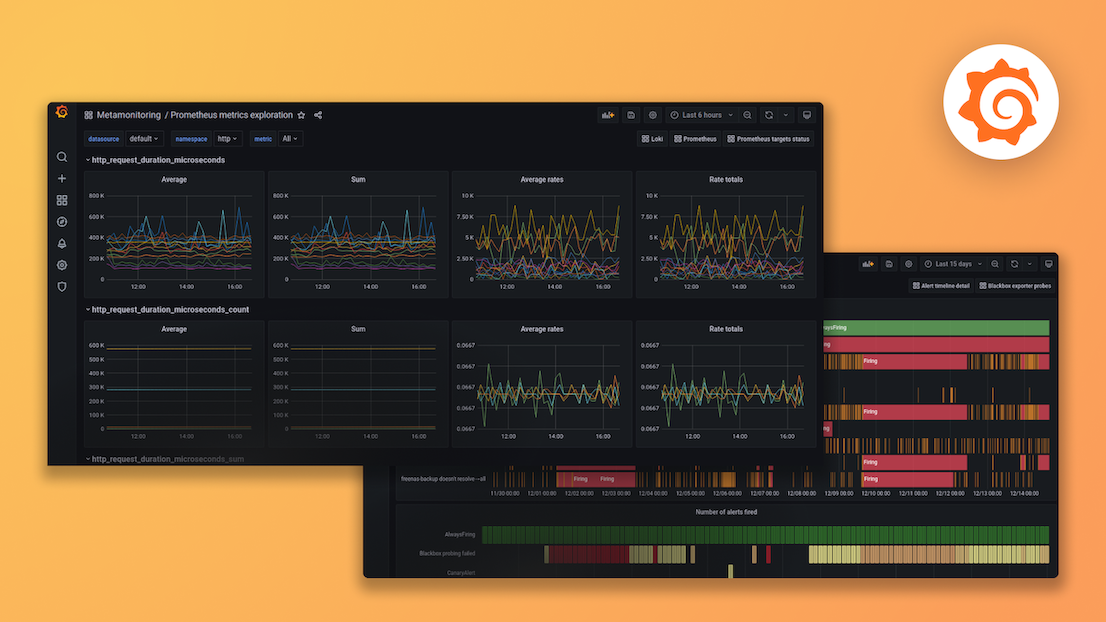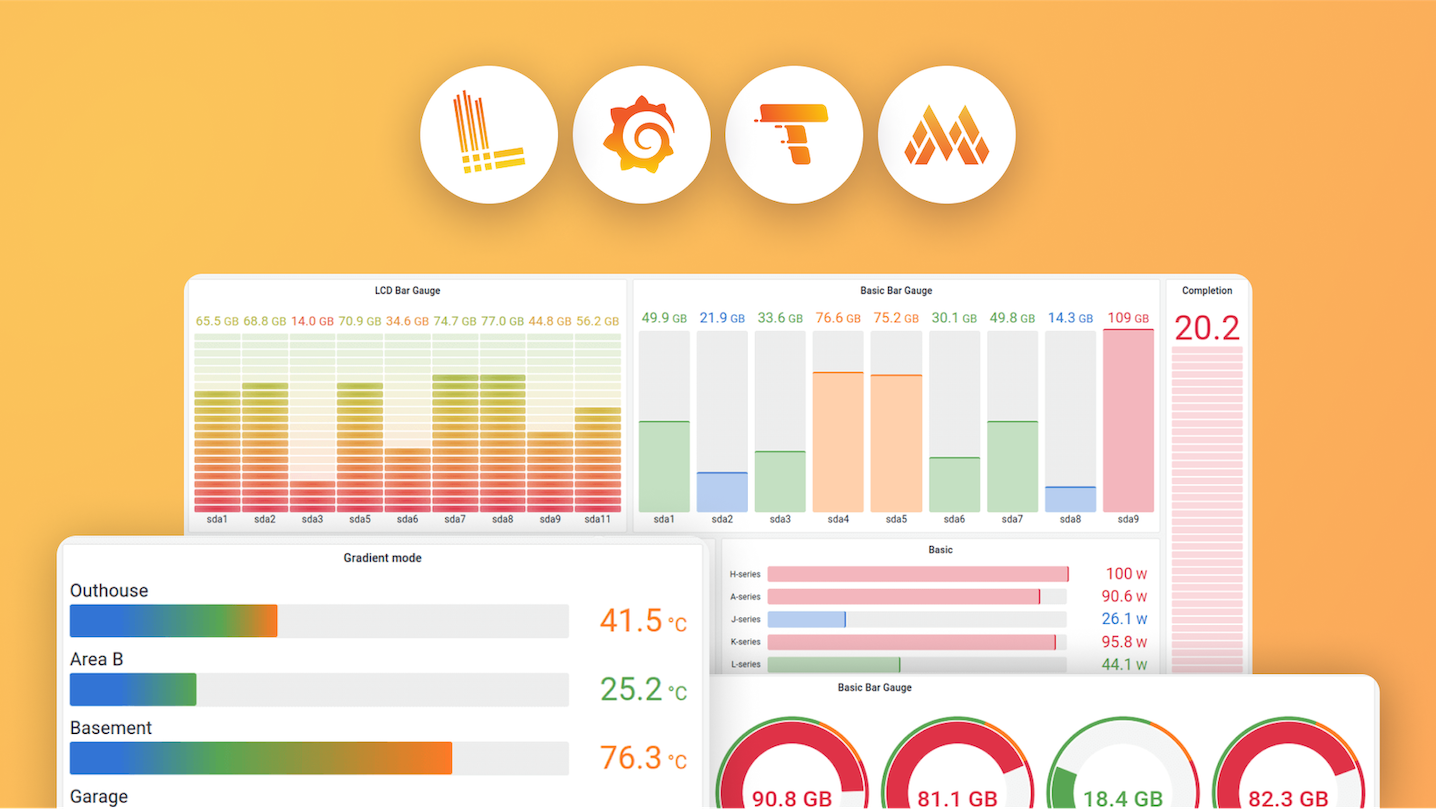Plugins 〉AppDynamics
AppDynamics
Instantly visualize AppDynamics data in Grafana
The AppDynamics data source plugin is the easiest way to pull AppDynamics data directly into Grafana dashboards.
- Visualize it either in isolation (one database) or blend it with other data sources.
- Discover correlations and covariances across all your data in minutes.
Grafana Cloud Free
- Free tier: Limited to 3 users
- Paid plans: $55 / user / month above included usage
- Access to all Enterprise Plugins
- Fully managed service (not available to self-manage)
Self-hosted Grafana Enterprise
- Access to all Enterprise plugins
- All Grafana Enterprise features
- Self-manage on your own infrastructure
Grafana Cloud Free
- Free tier: Limited to 3 users
- Paid plans: $55 / user / month above included usage
- Access to all Enterprise Plugins
- Fully managed service (not available to self-manage)
Self-hosted Grafana Enterprise
- Access to all Enterprise plugins
- All Grafana Enterprise features
- Self-manage on your own infrastructure
Grafana Cloud Free
- Free tier: Limited to 3 users
- Paid plans: $55 / user / month above included usage
- Access to all Enterprise Plugins
- Fully managed service (not available to self-manage)
Self-hosted Grafana Enterprise
- Access to all Enterprise plugins
- All Grafana Enterprise features
- Self-manage on your own infrastructure
Grafana Cloud Free
- Free tier: Limited to 3 users
- Paid plans: $55 / user / month above included usage
- Access to all Enterprise Plugins
- Fully managed service (not available to self-manage)
Self-hosted Grafana Enterprise
- Access to all Enterprise plugins
- All Grafana Enterprise features
- Self-manage on your own infrastructure
Grafana Cloud Free
- Free tier: Limited to 3 users
- Paid plans: $55 / user / month above included usage
- Access to all Enterprise Plugins
- Fully managed service (not available to self-manage)
Self-hosted Grafana Enterprise
- Access to all Enterprise plugins
- All Grafana Enterprise features
- Self-manage on your own infrastructure
Installing AppDynamics on Grafana Cloud:
Installing plugins on a Grafana Cloud instance is a one-click install; same with updates. Cool, right?
Note that it could take up to 1 minute to see the plugin show up in your Grafana.
Installing plugins on a Grafana Cloud instance is a one-click install; same with updates. Cool, right?
Note that it could take up to 1 minute to see the plugin show up in your Grafana.
Installing plugins on a Grafana Cloud instance is a one-click install; same with updates. Cool, right?
Note that it could take up to 1 minute to see the plugin show up in your Grafana.
Installing plugins on a Grafana Cloud instance is a one-click install; same with updates. Cool, right?
Note that it could take up to 1 minute to see the plugin show up in your Grafana.
Installing plugins on a Grafana Cloud instance is a one-click install; same with updates. Cool, right?
Note that it could take up to 1 minute to see the plugin show up in your Grafana.
Installing plugins on a Grafana Cloud instance is a one-click install; same with updates. Cool, right?
Note that it could take up to 1 minute to see the plugin show up in your Grafana.
Installing plugins on a Grafana Cloud instance is a one-click install; same with updates. Cool, right?
Note that it could take up to 1 minute to see the plugin show up in your Grafana.
For more information, visit the docs on plugin installation.
Installing on a local Grafana:
For local instances, plugins are installed and updated via a simple CLI command. Plugins are not updated automatically, however you will be notified when updates are available right within your Grafana.
1. Install the Data Source
Use the grafana-cli tool to install AppDynamics from the commandline:
grafana-cli plugins install The plugin will be installed into your grafana plugins directory; the default is /var/lib/grafana/plugins. More information on the cli tool.
Alternatively, you can manually download the .zip file for your architecture below and unpack it into your grafana plugins directory.
Alternatively, you can manually download the .zip file and unpack it into your grafana plugins directory.
2. Configure the Data Source
Accessed from the Grafana main menu, newly installed data sources can be added immediately within the Data Sources section.
Next, click the Add data source button in the upper right. The data source will be available for selection in the Type select box.
To see a list of installed data sources, click the Plugins item in the main menu. Both core data sources and installed data sources will appear.
Change Log
v3.7.0 - 2024-03-27
- ⚙️ Chore: Add error source and update backend dependencies
v3.6.3 - 2024-04-03
- 🐛 Fix: Fix queries failing when app name contains
+sign
v3.6.2 - 2024-03-15
- 🐛 Fix: fix connection issues (revert error source change)
v3.6.1 - 2024-03-13
- ⚙️ Chore: Backend binaries are now compiled with Go version
1.22.1
v3.6.0 - 2024-02-12
- ⚙️ Chore: Add error source for tracking errors
v3.5.0 - 2024-01-22
- 🚀 Feature: Query Tiers and Metric Names
v3.4.0 - 2023-11-16
- 🚀 Feature: Health and Events
v3.3.1 - 2023-11-22
- 🐛 Fix: Fix analytics data duplication in response when response says there is more data but there is no scroll id
v3.3.0 - 2023-10-26
- ⚙️ Chore: Update backend and frontend dependencies
- ⚙️ Chore: Minimal supported Grafana version is now
9.5.13
v3.2.2 - 2023-08-11
- ⚙️ Chore: update backend dependencies
v3.2.1 - 2023-08-09
- 🐛 Fix: Fix plugin failures which happened sometimes when
*was used in a metric query - ⚙️ Chore: Backend binaries are now compiled with Go version
1.21.0
v3.2.0 - 2023-07-10
- 🐛 Fix: Improve authentication error handling
v3.1.1 - 2023-06-08
- ⚙️ Chore: backend libs updated with golang:1.20.5
v3.1.0 - 2023-05-25
- 🚀 Feature: Secure socks proxy support added
- ⚙️ Chore: Update plugin frontend build system (migrate from @grafana/toolkit to @grafana/create-plugin)
- ⚙️ Chore:
grafana-plugin-sdk-goupdated from 0.148.0 to 0.161.0 - ⚙️ Chore: updated backend resource call types with mux
v3.0.16 - 2023-05-03
- ⚙️ Chore: Backend binaries are now compiled with Go version
1.20.4which contains security fixes
v3.0.15 - 2023-04-21
- ⚙️ Chore: Backend SDK version downgraded to
v0.148.0( it was causing data encoding errors for some customers running 3.0.12-3.0.14 versions of the plugin)
v3.0.14 - 2023-04-19
- ⚙️ Chore: Backend dependencies updated
- ⚙️ Chore: Backend binaries are now compiled with Go version
1.20.3which contains security fixes
v3.0.13 - 2023-04-13
- 🐛 Fix: (Analytics) Fixed a bug where multi-value variables weren't interpolated correctly
- ⚙️ Chore: Backend is now compiled with golang 1.20.3
v3.0.12 - 2023-04-05
- 🐛 Fix: Fix query when using min/max aggregations
- ⚙️ Chore: Grafana backend SDK updated from
v0.147.0tov0.156.0
v3.0.11 - 2023-03-29
- 🐛 Fix: Set default query type as "metrics" (helps customers who upgrade from versions before
2.3.0)
v3.0.10 - 2023-03-28
- 🐛 Fix: Update frontend dependencies which fixes polluting global styles for date inputs
- ⚙️ Chore: Minimal supported Grafana version is now
8.4.7
v3.0.9 - 2023-03-01
- 🐛 Fix: Fix broken UI in datasource config page for Grafana
9.4
v3.0.8 - 2023-02-23
- 🐛 Fix: Fixed an issue when empty response had
timefield while it should have no fields - 🐛 Fix: Fixed an issue when hidden queries were still being executed
v3.0.7 - 2023-02-09
- 🐛 Fix: Fixed an issue where plugin panics when empty response received from AppDynamics
v3.0.6 - 2023-01-18
- 🐛 Fix: Fixed an issue where additional labels were sent when using segment labels
v3.0.5 - 2022-12-19
- ⚙️ Chore: Backend binaries are compiled with go 1.19.4
- ⚙️ Chore: Grafana backend plugin SDK updated to latest (v0.147.0 from v0.144.0)
v3.0.4 - 2022-11-24
- Added support for fields of array type in analytics queries
v3.0.3 - 2022-11-02
- Backend binaries are compiled with go 1.19.3
v3.0.2 - 2022-08-08
- Added debug logging
- Removed 500 error when no response is received
- Updated error messages to be more descriptive
v3.0.1 - 2022-07-22
- Added metric labels for the queries created before 3.0.0
- Handle both json boolean types, and string representations of boolean types
v3.0.0 - 2022-06-22
- Performance improvements
- Add support for specifying more than one variable in a metric path
- Migrated to wide data frame series with support for labels
- All the metric path segments are now available as labels
BREAKING CHANGES
- Removed support for multi-value variables in metric paths. If multi value variables found in metric path, they will be replaced with
*. In previous version of the plugin, if multi value variables found in metric path they were expanded into multiple queries which was causing performance issues. Also the underlying AppDynamics API only supports either single value or*in the metric path. The API doesn't support multiple wildcards in the metric path - Removed support for Time Offset query option. Use grafana dashboard panel's Time shift instead.
- Removed support for TopX transformation. Use grafana panel transformations instead.
- Removed support for App on legend. Use
{{ app }}prefix in the custom legend instead.
v2.5.1 - 2022-03-24
- New builds with go 1.18 to address CVE-2022-24921
v2.5.0 - 2022-03-08
- 🚀 Feature: Showing API URLs in the query inspector
v2.4.3 - 2021-12-21
- Limit analytics scrolling to max data points
v2.4.2 - 2021-12-17
- Enterprise license check update
v2.4.1 - 2021-11-03
- Fixed an issue where applications that are returned with a
nullstring are ignored
v2.4.0 - 2021-10-21
- Added authentication through API Keys that refreshes automatically. See Appdynamics Documentation
v2.3.5 - 2021-09-28
- Allow custom values in the applications segment
v2.3.4 - 2021-09-09
- Fixes an issue with Analytics field type conversion
v2.3.3 - 2021-09-09
- Fixes an issue with using aggregations and math operations in Analytics queries
v2.3.2 - 2021-08-20
- Fixes a variable interpolation issue
v2.3.1 - 2021-08-06
- Fixes an issue with using AppDynamics in Mixed queries
v2.3.0 - 2021-08-04
- Adds Analytics Events
[2.3.0-beta.1] - 2021-06-07
- Analytics Events Beta
v2.1.3 - 2021-06-17
- #130: Enable new error message format for health diagnostics
v2.1.2 - 2021-04-21
- #121: AppDynamics: Ensure default delimiter is present
v2.1.1 - 2021-04-12
- ⚙️ Chore: Update SDK
v2.1.0 - 2021-01-21
Bug Fixes
- #72: AppDynamics: Error in creating queries using 3 variables
- This resolves a known issue when using template variables with multiple entries
- #100: Swap in the new AppD Logo
Enhancements
- #93: Authenticate with an API Client
v2.0.1 - 2021-01-14
- #80: AppDynamics | Plugin Health Check Failed after upgrading to v2.0.0
- #72: AppDynamics: Error in creating queries using 3 variables
- Nil pointer fix when doing healthcheck
- #85: Fix for regex crashes
- #82: Skip TLS Verify not working
- #81: Ensure response is created and valid
- #73: Add wildcards to the dropdown to select multiple metrics
- #72: Template variables that resolve to multiple entries do not work
v2.0.0 - 2020-09-01
- Now Supports Alerting
- Rewrite with new backend
v1.4.4 - 2020-05-14
- 🐛 Fix: for Template Variables in Server Visibility, values are not expanding
v1.4.3 - 2020-05-12
Plugin is now signed for V7
v1.4.2 - 2020-05-05
Fix: [#48] When templating, look for '$' explicitly
v1.4.1 - 2019-10-21
- 🐛 Fix: for Template Variables in Server Visibility, values are not expanding
v1.4.0 - 2019-10-04
- Added jest placeholder to webpack
- Added docker-compose.yml
- Added circleci publishing
- Update packages
v1.3.0 - 2019-05-24
- New legend key formatting option - Custom legend keys with alias patterns.
- Show Metadata section in the query editor. Shows the Legend Key per query and the metric path segments. Useful when you need to map legend keys (or aliases) in panels like the Worldmap panel or Singlestat Math panel.




